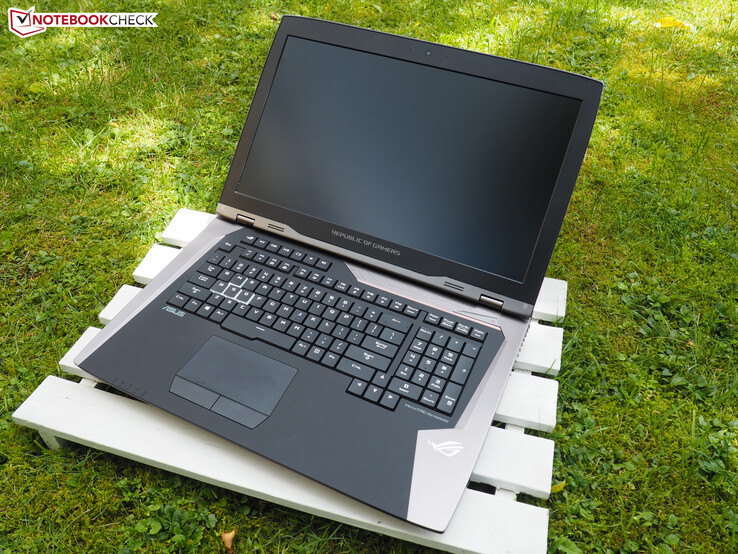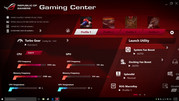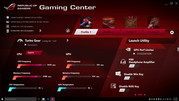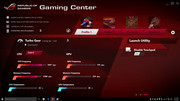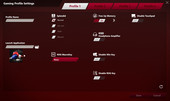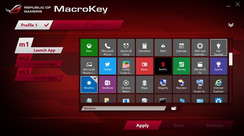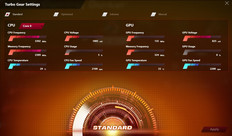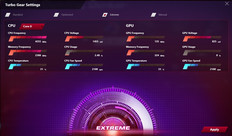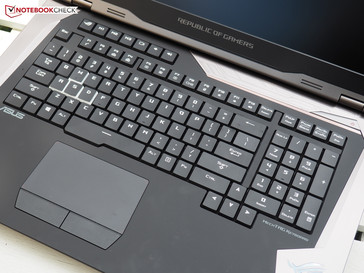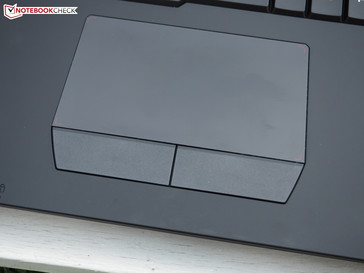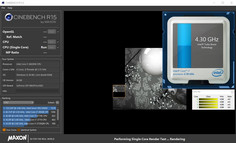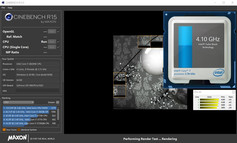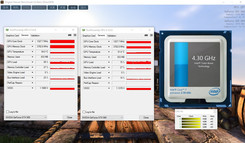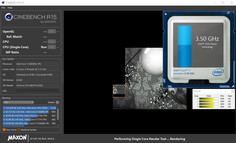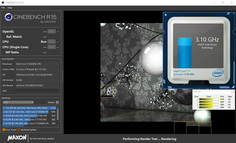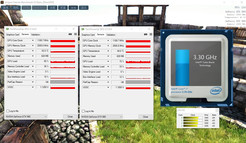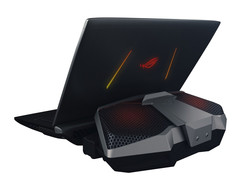Asus ROG GX800 Notebook Preview
For the original German review, see here.
Asus GX700 meets MSI GT80: This would be a good summary for the brand-new GX800 in one sentence. While the external water cooling (Hydro Overclocking System) did not change, the chassis grew from 17 to 18 inches to make room for a dual-GPU solution. To make sure not to fall behind MSI and justify the extreme price, Asus includes the most powerful Notebook GPUs on the market. Nvidia's Pascal generation still needs some time, so our review unit has to get along with two Maxwell chips, more precisely the GTX 980 SLI (buyers of the final product will get the top next-gen GPUs). This means the benchmark results and emissions as well as energy measurements are not representative for the final product.
Link: Notebookcheck Review of the Asus ROG GX800VH with Nvidia Geforce GTX 1080 SLI
Another difference is the display. Contrary to the prototype, the final product is not supposed to be equipped with a Full HD, but a UHD panel with G-Sync support (supposedly the first 18-inch model in the world). Because of the very early product stage we are not going to evaluate some sections. Asus is still tweaking the following aspects until the launch:
- Input devices (keyboard & touchpad)
- Case (build quality etc.)
- Software (tools, driver, etc.)
- Communication (Wi-Fi)
- System stability
- Battery runtime
- Cooling system
- Sound
Case
The design is very similar to the 17-inch sibling GX700. Asus once again uses a combination of metal (lid) and plastic (some rubberized), which can live up to the quality of the main rival from MSI, the GT80S. Because of the bigger screen and twice the GPU performance, however, the chassis is bulkier and heavier compared to the GX700.
The GX800 tips the scale at 5.69 kilograms – almost 50% more compared to the 3.9 kg of the GX700. This means the whole system with the water cooling (4.7 kg) weighs more than 10 kg. Adding both power adapters (1280 grams each), the total weight will be 13 kilograms. The MSI GT80S with identical components, but without water cooling and just one power adapter, "only" weighs 6.3 kilograms including the PSU.
But it does not really matter if you have the GX800 or GT80S: Neither device is really suited for frequent transportation. Both notebooks are primarily designed for users that want a stationary system, but not a big desktop PC. Otherwise, the chassis leaves a very good impression. Besides the design, we also liked the sturdiness. More information about the water cooling is available in the review of the GX700. The latter still has the same strengths (cooling performance) and weaknesses (space requirements), even though there are multiple optimizations according to Asus. Besides the GPU, the CPU is now cooled as well, for instance.
Connectivity
Ports
The port variety of the test model is just as comprehensive as the GX700. Among others, Asus deserves respect for the video ports. Thanks to HDMI 2.0, DisplayPort 1.4 and Thunderbolt 3.0, you can attach all kinds of monitors and drive them at 3840x2160 pixels at 60 Hz. Three USB 3.0 ports and two USB 3.1 ports (Type-C) are also very generous. The back is reserved for the water cooling, so Asus was forced to distribute the ports across the sides. The majority of ports are now at least on the left instead of the right side, which is better for the majority of users (keyword external mouse).
Card Reader
The card reader is a very fast model. Almost 228 MB/s sequential read and 159 MB/s when we transfer 250 jpg pictures are above average and comparable to the Schenker XMG U726.
| SD Card Reader | |
| average JPG Copy Test (av. of 3 runs) | |
| Asus GX700 | |
| Schenker XMG U726 | |
| Asus GX800 Prototype | |
| MSI GT80S 6QF | |
| maximum AS SSD Seq Read Test (1GB) | |
| Asus GX700 | |
| Asus GX800 Prototype | |
| Schenker XMG U726 | |
| MSI GT80S 6QF | |
Communication
Communications are handled by a Gigabit-Ethernet controller as well as a modern wireless module. Asus promises WLAN 802.11 a/b/g/n/ac (2x2 antennas) and Bluetooth 4.1. Our test model was equipped with Intel's Wireless-AC 8260. There is even a Wi-Fi antenna port at the chassis.
Software
The software has a lot of potential. Not only can you adjust several system settings and monitor the components via Gaming Center, but you can also overclock the processor, graphics card and memory. While the Core i7-6820HK usually manages up to 3.6 GHz, the Turbo Gear setting "Extreme" (activated by default when you boot Windows) will increase the clock up to 4.4 GHz, which is 22% faster than default.
The GPU overclocking is not bad, either. In the case of the GTX 980, the Extreme mode will result in 1328 instead of 1190 MHz for the core (+12%) and 3700 instead of 3500 MHz for the VRAM (+6%). MSI only overclocks the CPU in the GT80S, so the GX800 can – depending on the title or benchmark, respectively – manage a significant lead. Finally, you can also overclock the DDR4-RAM (2800 instead of 2400 MHz).
The Gaming Center is rounded off by a manual fan control for the water cooling and the notebook. Our tests were performed with the setting "Auto". Turbo Gear was set to "Standard" while idling and "Extreme" for 3D loads. Similar to the GX700, the video memory will only reach the clocks of a GTX 980M (2500 MHz) without the water cooling.
Maintenance
The maintenance is unfortunately still complicated (see GX700 review). The manufacturer once again waives a maintenance hatch, so you have to remove the whole bottom panel to access the battery, the cooling system, the storage devices and the memory slots.
Accessories
Similar to the GX700, the GX800 is supposed to be shipped with a suitcase.
Input Devices
Despite our prototype status, the input devices already leave a promising impression. Asus uses the GT80S as a role model and implements a mechanical keyboard. The keys, however, are much flatter, so the keyboard can be placed further at the top (better ergonomics) and there is room for a conventional touchpad. Other highlights are the separated directional keys, the dedicated macro area, and the stylish illumination. Inputs feel firmer and more precise (at the cost of typing noise) compared to a standard keyboard. The touchpad convinces with the smooth finish and the size.
Display
We already mentioned that the final GX800 will be equipped with a UHD-IPS panel, and Nvidia's G-Sync technology will be available as well. The latter prevents line shifts and ensures a smooth presentation. Our prototype only had an FHD display without G-Sync, so we did not perform any measurements.
Performance
The Asus GX800 is currently the fastest desktop replacement, even without the next-gen GPUs for the final product. Almost all gaming notebooks are equipped with a high-end quad-core processor, but none of the rivals can compete with the graphics performance. The memory equipment is excellent as well: 64 GB DDR4-RAM should be easily sufficient over the next couple of years. The icing on the cake is the three NVMe-SSDs in a RAID-0 configuration.
Processor
Asus uses the Core i7-6820HK from Intel's Skylake generation. This quad-core chip has a TDP of 45 Watts and is manufactured in a 14 nm process. The L3 cache is 8 MB and therefore slightly bigger compared to the popular Core i7-6700HQ (6 MB).
We already mentioned that the clocks depend on the Turbo Gear setting. The maximum will be 3.6 GHz without overclocking, while the chip can reach more than 4 GHz in the Extreme setting. We do not evaluate the clocks via Cinebench yet, because the water block or its contact with the CPU, respectively, is not yet finalized. The same applies for the temperatures later in this article.
| Cinebench R15 - CPU Single 64Bit | |
| Asus GX800 Prototype | |
| MSI GT80S 6QF | |
| Asus GX700 | |
| Schenker XMG U726 | |
| Cinebench R11.5 - CPU Single 64Bit | |
| Asus GX800 Prototype | |
| MSI GT80S 6QF | |
| Asus GX700 | |
| Schenker XMG U726 | |
System Performance
There is nothing to improve in respect to the system performance. 8047 points in PCMark 7 is the highest score we ever measured (including desktop PCs). The main reason for the great result is the RAID configuration consisting of multiple M.2-SSDs.
| PCMark 7 Score | 8047 points | |
Help | ||
| PCMark 7 - Score | |
| Asus GX800 Prototype | |
| Asus GX700 | |
| MSI GT80S 6QF | |
| Schenker XMG U726 | |
Storage Devices
This brings us to the next section: the storage devices. Asus does not make any compromises in this regard and uses three NVMe-SSDs from Samsung (SM951) with a capacity of 512 GB each. Both AS SSD and CrystalDiskMark often see the GX800 at the top of the charts. Almost 3000 MB/s sequential read and 2400-2600 MB/s sequential write are outstanding results. Small files are quickly handled by the Solid State Drive as well, so Windows is really responsive (boot, loading times, etc.).
| Asus GX800 Prototype 3x Samsung SM951 512 GB NVMe M.2 (RAID 0) | MSI GT80S 6QF 2x Samsung SM951 MZVPV256HDGL (RAID 0) | Asus GX700 2x Samsung SM951 MZVPV512HDGL (RAID 0) | Schenker XMG U726 Samsung SM951 MZHPV512HDGL m.2 PCI-e | |
|---|---|---|---|---|
| AS SSD | -9% | -4% | -32% | |
| Seq Read (MB/s) | 2997 | 2892 -4% | 2964 -1% | 1943 -35% |
| Seq Write (MB/s) | 2371 | 2408 2% | 2525 6% | 1500 -37% |
| 4K Read (MB/s) | 47.23 | 44.96 -5% | 46.43 -2% | 40.45 -14% |
| 4K Write (MB/s) | 127.1 | 109.9 -14% | 119.6 -6% | 103.6 -18% |
| Score Total (Points) | 4312 | 3336 -23% | 3655 -15% | 1930 -55% |
GPU Performance
Even though it does not really make a lot of sense to test the graphics cards, which will not be available in the final product, we ran many benchmarks with the GTX 980 SLI. One reason was to add missing titles to our gaming list. The second reason is to have more results for comparisons of the efficiency and performance after the launch of the Pascal architecture.
But back to our prototype: The GeForce GTX 980 is – SLI or not – the most powerful notebook GPU at the time of writing. The top model from Nvidia is based on the already slightly aged Maxwell architecture, which is still manufactured in a 28 instead of 16 nm process. It has 2048 CUDA cores and therefore much more than the less expensive siblings GTX 980M (1536) and GTX 970M (1280), which has a big effect on the performance. There is also no criticism for the video memory (8 GB GDDR5) or memory interface (256-bit).
| 3DMark 11 Performance | 22627 points | |
| 3DMark Ice Storm Standard Score | 197819 points | |
| 3DMark Cloud Gate Standard Score | 35100 points | |
| 3DMark Fire Strike Score | 19513 points | |
Help | ||
Great: The GTX 980 can utilize its full potential in the Extreme mode. Our benchmarks show that the 18-inch device heavily benefits from overclocking. 3DMark 13 and 3DMark 11 determine scores for the GX800 that are between 10 and 20% faster than the MSI GT80S. If Asus keeps the Turbo Gear system, the difference should also apply for the Pascal versions of the two laptops (except MSI also decides to overclock the graphics card of the GT80 successor).
A couple more words about SLI: Dual-GPU notebooks offer more performance than single-chip solutions, but there are some drawbacks. This starts with the power consumption and continues with the cooling requirements all the way up to the driver dependency. To make sure you are not slowed down by modern games, you should update the driver regularly (we replaced the preloaded ForceWare 362.34 with the brand-new version 368.39 for our gaming tests). Micro-stutters are usually no problem for the desktop replacement, because the frame rate – even at maximum details in 4K – rarely drops below 50 fps.
| 3DMark | |
| 1920x1080 Fire Strike Score | |
| Asus GX800 Prototype | |
| MSI GT80S 6QF | |
| Asus GX700 | |
| Schenker XMG U726 | |
| 1920x1080 Fire Strike Graphics | |
| Asus GX800 Prototype | |
| MSI GT80S 6QF | |
| Asus GX700 | |
| Schenker XMG U726 | |
| 3DMark 11 | |
| 1280x720 Performance | |
| Asus GX800 Prototype | |
| MSI GT80S 6QF | |
| Asus GX700 | |
| Schenker XMG U726 | |
| 1280x720 Performance GPU | |
| Asus GX800 Prototype | |
| MSI GT80S 6QF | |
| Asus GX700 | |
| Schenker XMG U726 | |
| Unigine Heaven 4.0 - Extreme Preset DX11 | |
| Asus GX800 Prototype | |
| MSI GT80S 6QF | |
| Schenker XMG U726 | |
| Asus GX700 | |
Gaming Performance
Except for the weaker settings, where the GX800 is sometimes limited by the CPU, the SLI system results in significant performance gains. If you take all the results from the FHD and 4K benchmarks (graphics settings Ultra or High, respectively), the dual-GPU system is 60% faster than a single GTX 980, and even Nvidia's high-end desktop chip GTX 1080 is beaten by 10%. It will be interesting to see how the final product with Pascal will perform. The 18-inch device is at least one of the few devices we would call "4K-ready". Except for XCOM 2, all titles ran smoothly with 3840x2160 pixels and high details.
| Mirror's Edge Catalyst | |
| 3840x2160 High Preset AF:16x | |
| Asus GX800 Prototype | |
| Nvidia GeForce GTX 1080 Founders Edition | |
| Asus GX800 Prototype | |
| 1920x1080 Ultra Preset AF:16x | |
| Nvidia GeForce GTX 1080 Founders Edition | |
| Asus GX800 Prototype | |
| Asus GX800 Prototype | |
| Overwatch | |
| 3840x2160 High (Render Scale 100 %) AA:SM AF:4x | |
| Asus GX800 Prototype | |
| Nvidia GeForce GTX 1080 Founders Edition | |
| Asus GX800 Prototype | |
| 1920x1080 Epic (Render Scale 100 %) AA:SM AF:16x | |
| Asus GX800 Prototype | |
| Nvidia GeForce GTX 1080 Founders Edition | |
| Asus GX800 Prototype | |
| Doom | |
| 3840x2160 High Preset AA:FX | |
| Asus GX800 Prototype | |
| Nvidia GeForce GTX 1080 Founders Edition | |
| Asus GX800 Prototype | |
| 1920x1080 Ultra Preset AA:SM | |
| Asus GX800 Prototype | |
| Nvidia GeForce GTX 1080 Founders Edition | |
| Asus GX800 Prototype | |
| Need for Speed 2016 | |
| 3840x2160 High / On AA:FX | |
| Asus GX800 Prototype | |
| Nvidia GeForce GTX 1080 Founders Edition | |
| Asus GX800 Prototype | |
| 1920x1080 Ultra / On AA:T | |
| Nvidia GeForce GTX 1080 Founders Edition | |
| Asus GX800 Prototype | |
| Asus GX800 Prototype | |
| Hitman 2016 | |
| 3840x2160 High / On AA:FX AF:8x | |
| Asus GX800 Prototype | |
| Nvidia GeForce GTX 1080 Founders Edition | |
| Asus GX800 Prototype | |
| 1920x1080 Ultra / On AA:SM AF:16x | |
| Nvidia GeForce GTX 1080 Founders Edition | |
| Asus GX800 Prototype | |
| Asus GX800 Prototype | |
| The Division | |
| 3840x2160 High Preset AF:8x | |
| Asus GX800 Prototype | |
| Nvidia GeForce GTX 1080 Founders Edition | |
| Asus GX800 Prototype | |
| 1920x1080 Ultra Preset AF:16x | |
| Asus GX800 Prototype | |
| Nvidia GeForce GTX 1080 Founders Edition | |
| Asus GX800 Prototype | |
| Far Cry Primal | |
| 3840x2160 High Preset AA:SM | |
| Asus GX800 Prototype | |
| Nvidia GeForce GTX 1080 Founders Edition | |
| Asus GX800 Prototype | |
| 1920x1080 Ultra Preset AA:SM | |
| Nvidia GeForce GTX 1080 Founders Edition | |
| Asus GX800 Prototype | |
| Asus GX800 Prototype | |
| XCOM 2 | |
| 3840x2160 High Preset AA:FX AF:8x | |
| Asus GX800 Prototype | |
| Nvidia GeForce GTX 1080 Founders Edition | |
| Asus GX800 Prototype | |
| 1920x1080 Maximum Preset (8xMSAA instead of FXAA) AA:8xMS AF:16x | |
| Asus GX800 Prototype | |
| Nvidia GeForce GTX 1080 Founders Edition | |
| Asus GX800 Prototype | |
| Rise of the Tomb Raider | |
| 3840x2160 High Preset AA:FX AF:4x | |
| Asus GX800 Prototype | |
| Nvidia GeForce GTX 1080 Founders Edition | |
| Nvidia GeForce GTX 1080 Founders Edition | |
| Asus GX800 Prototype | |
| 1920x1080 Very High Preset AA:FX AF:16x | |
| Nvidia GeForce GTX 1080 Founders Edition | |
| Nvidia GeForce GTX 1080 Founders Edition | |
| Nvidia GeForce GTX 1080 Founders Edition | |
| Asus GX800 Prototype | |
| Asus GX800 Prototype | |
| low | med. | high | ultra | 4K | |
|---|---|---|---|---|---|
| Rise of the Tomb Raider (2016) | 107.3 | 95 | 94.7 | 94.4 | 60.9 |
| XCOM 2 (2016) | 129.6 | 109.5 | 108 | 59.9 | 39 |
| Far Cry Primal (2016) | 98 | 97 | 86 | 85 | 56 |
| The Division (2016) | 226 | 189.9 | 126.5 | 100.6 | 55.1 |
| Hitman 2016 (2016) | 84.8 | 79.7 | 72 | 70.6 | 54.6 |
| Need for Speed 2016 (2016) | 133.4 | 122.4 | 121.4 | 93.1 | 75.1 |
| Doom (2016) | 192.7 | 189.8 | 168.7 | 160.3 | 70.3 |
| Overwatch (2016) | 299.9 | 299.8 | 299.8 | 297.4 | 143 |
| Mirror's Edge Catalyst (2016) | 197.4 | 145.4 | 124.4 | 119.3 | 48.3 |
Emissions
System Noise
It does not make much sense to check the noise development of the GX800 due to the unfinished fan control. Subjectively, the 18-inch notebook is as loud as the MSI GT80S. The final product is – depending on the load – supposed to be much quieter than the prototype.
Temperature
Asus asked that we did not have a detailed look at the temperature development, since both the keyboard and the palm rest will be equipped with a special mat that shields the heat from the inside. The results of the test model remind us of the GX700.
Speakers
We do not evaluate the sound quality, either. Asus wants to equip the GX800 with two 34 mm speakers rated at 2 Watts and two 28 mm speakers rated at 3 Watts.
Energy Management
Power Consumption
Asus ships the GX800 with two 330-Watt power adaptors (1x for the notebook and 1x for the water cooling) to cover the enormous power consumption. That 660 Watts are not overkill is confirmed by our measurements. Up to 590 Watts under maximum load and almost 200 Watts in the first scene of 3DMark06 remind us of a desktop PC.
Another comparison with the GT80S, where the GPUs are not overclocked: The rival from MSI is much more frugal with 411 and 163 Watts, respectively. The GX800 pulls between 58 and 74 Watts from the socket while idling – again more than the GT80S (44-62 Watts). Our table shows how notebooks with a single-GPU perform.
| Off / Standby | |
| Idle | |
| Load |
|
Key:
min: | |
| Asus GX800 Prototype GeForce GTX 980 SLI (Laptop), 6820HK | MSI GT80S 6QF GeForce GTX 980 SLI (Laptop), 6820HK | Asus GX700 GeForce GTX 980 (Laptop), 6820HK | Schenker XMG U726 GeForce GTX 980 (Laptop), 6700 | |
|---|---|---|---|---|
| Power Consumption | 22% | 34% | 36% | |
| Idle Minimum * (Watt) | 58 | 44 24% | 40 31% | 36 38% |
| Idle Average * (Watt) | 68 | 53 22% | 45 34% | 45 34% |
| Idle Maximum * (Watt) | 74 | 62 16% | 51 31% | 53 28% |
| Load Average * (Watt) | 200 | 163 18% | 149 25% | 139 30% |
| Load Maximum * (Watt) | 590 | 411 30% | 313 47% | 306 48% |
* ... smaller is better
Battery Runtime
We wait for the final product for our runtime tests. The 8-cell battery is supposed to have a capacity of 76 Wh (93 Wh @GX700).
Pros
Cons
Verdict
Thanks to the external water cooling, the notebook from Asus is probably one of the most interesting concepts from the last couple of years. The GX700 was already a unique product, which gets a worthy successor with the GX800.
The main focus is the performance and the features. Not only the number or capacity of Solid State Drives was increased but also the number of GPUs. Following the concept "two are better than one", the notebook is now equipped with two high-end GPUs from Nvidia. Thanks to overclocking, they manage frame rates that were not possible so far and make the user ready for 4K.
The SLI system does, however, affect the weight and the power consumption, which are pretty high. The UHD panel with G-Sync support and the generous port variety (USB 3.1 Type-C, Thunderbolt 3, HDMI 2.0, etc.) are another big advantage.
The GX800 is neck and neck with the dual-GPU rival MSI GT80S (or more precisely its successor), which has its own set of advantages and drawbacks but uses a classic concept without water cooling.
There will obviously be a "real" review as soon as we get our hands on the final product.
Link: Notebookcheck Review of the Asus ROG GX800VH with Nvidia Geforce GTX 1080 SLI





